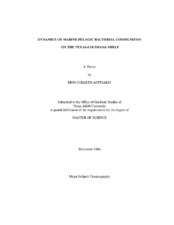| dc.description.abstract | Microbial community interactions within many ecosystems are still relatively
unknown. Investigating links between environmental dynamics and shifting pelagic
bacterial community structures on the Texas-Louisiana shelf, Eubacterial community
profiles of Operational Taxonomic Units (OTUs) were generated using Automated
Ribosomal Intergenic Spacer Analysis (ARISA) of the 16S rDNA and 23S rDNA
intergenic spacer region. This ITS region is highly variable in both length and sequence.
Community diversity was assessed by the comparison of ARISA-generated community
fingerprints of samples collected from four distinct regions along the Texas-Louisiana
shelf in a cross-shelf pattern on 10m, 20m, and 40m isobaths.
Incubations of samples with a thymidine analog, 5-Bromodeoxyuridine (BrdU),
allowed for the isolation and analysis of the actively growing subset within the total
bacterial population. Community composition was determined through the construction
of clone libraries for sequencing and putative phyla affiliation of community 16 rRNA
genes. Hydrographic data were also collected for analysis of shifts in microbial
community diversity correlated with a variety of influential environmental factors.
ARISA profiles of Eubacterial species richness suggest strong distinction between the
two communities found within Zones A and C along the Texas-Louisiana Shelf.
Further analysis of salinity gradients originating from the two main fluvial
sources, the Mississippi and the Atchafalaya Rivers, identified possible sources of
variation between the individual communities. Whereas composition of these communities remains discrete between regions, the active subset of the population
becomes more similar across the shelf through the summer. Possibly due to undersampling
of hypoxic sites, no relationship could be determined between hypoxia
formation and the Eubacterial community dynamics. Several OTUs within the
communities were identifiable as α - and β - Proteobacteria, Actinobacteria,
Synechococcus, Prochlorococcus, and Cytophaga/Flavobacterium/Bacteroides.
Through validation studies of 5-Bromodeoxyuridine field sampling, this study
indicates the power of BrdU incorporation and ARISA analysis to study a dynamic
environmental system and explore the factors that determine the structure of the pelagic
community on the Texas-Louisiana Shelf. | en |


